The field of robotics is starting to show signs of exponential growth and technological advancement. Buzzwords like "singularity" are being discussed with more fervor in anticipation of a great advancement within the coming generations. However, the current disciplines associated with robots will not be the only guiding factors determining the future of robotics, as mankind's general technological and scientific abilities in other domains improve, they too can have a dramatic impact on the future of robotics. Can past technological accomplishments help predict future disruptive technology and innovations or should we try to think outside the box? Science fiction books, TV shows and movies provides a great source for inspiration, but what will robots really be like in the next 25, 50 or 100 years?
Robot Structure / Shape
Currently, most commercial
mobile robots use rigid
structures & frames manufactured out of aluminum, plastic and sometimes composites. In order to create these frames, classic and proven
manufacturing methods are used, including machining, plastic injection and composite molding, and standard PCB / electronics manufacturing. Since the manufacturing methods are so vastly different from one another, the electronics, mechanics and programming are created separately and form different and distinct parts of the robot which come together during assembly. Although
3D printing has been around for a while, personal 3D printers for the home, and the drop in the price of commercial 3D printers has given designers the chance to make professional products themselves rather than outsourcing. There is also a push towards modularity (electronics, mechanics and programming) and inter-compatibility between products from several
manufacturers, though a lot of the advancement comes from other fields.
What will robots look like in the not too distance future? Will they still be the cold, rectangular, non-emotional robots we have grown accustomed to, or might they be something entirely different? Research into material properties, combined with advanced manufacturing is giving some hints that the robots of the future may be nothing like what we are used to today.
 Flexible Circuits Flexible Circuits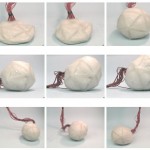 iRobot Chembot iRobot Chembot |
Flexible, Non-Rigid Structure
Current printed circuit board (PCB) technology allows for either rigid, multi-layered fiberglass-based boards, as well as flexible (mostly single or dual layer) boards. Stretchable electronics however allow the PCB traces, when printed on a flexible substrate, to be stretched, bent, folded and manipulated in multiple axes. This means the PCB no longer needs to be a flat rectangle, and curve on multiple planes, with the ability to conform to 3D shapes and bend and flex with them.
"Soft robots" are also being developed and involve using flexible materials in specific shapes (as well as some form of input, normally energy in the form of electricity or a liquid / gas to fill a cavity) to change shape and even achieve motion. Heavy actuators and gearing disappear from the design, allowing for lighter weight, more energy efficient mobile robots with fewer separate parts and potentially increased versatility because of not being constrained to one actuator per degree of freedom. Is a more biological actuator on the horizon? A team led by Stanford University materials scientist Zhenan Bao has created an artificial muscle which expands by a small percentage when subjected to a low electrical field. Additionally, the polymer muscle has the ability to fuse back together when punctured, giving it self-healing properties. The objective of this research is to learn more about engineered polymers which are electrically conductive, generate force and self-heal.
Out of the Box
Combining elastic electronics, soft robots and artificial muscles gives the possibility of almost merging a robot's physical structure with its electronics into one, semi-seamless robot creation. Not only could a soft robot change its shape to adapt to different situations and spaces, there is also the possibility of different methods of locomotion. This may lead to the possibility of "octopus-like" robots which can squeeze through tight spaces, mimic other creatures and objects and even self-heal. How might such a system work? To eliminate the need for a mechanically-driven energy supply (air compressor for example), one might instead use actuator wire integrated into a balloon which is filled with a liquid and, when activated causes the liquid to flow into areas of the soft robot. Rather than using relays or mechanical valves, flexible materials with magnetic particles built in (essentially electromagnets) could open and close on command, while still being able to stretch and flex. |
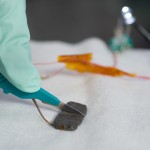 Robot Skin Robot Skin Cell Division Cell Division |
Robot Skin & Senses
How can robots have "skin" and what could be gained from this? Research groups at the University of California, Berkeley as well as Stanford are independently working on a type of skin which senses touch, conducts electricity and self-heals. Meanwhile, researchers at the University of Tokyo have build a flexible electronic skin using pressure sensitive rubber as well as organic transistors which are embedded on plastic film. The objective is to create an artificial skin which would not only provide a sense of touch with the ability to know the pressure and location of the contact, as well as a variety of other possible properties. Self-healing "skin" can be an evolution of self-repairing plastics. Kindergarten students are aware of the five senses; touch, sight, taste, smell and sound, but most well-educated adults would be hard pressed to name the others which have since been added or extrapolated, including a sense of time, movement, pain, pressure, balance and a host of others. Creating robotic equivalents to these is not always easy, nor is the programming needed in order to make proper use of them.
If there is the possibility of an artificial skin, why not an artificial cell? A team of Japanese biologists have successfully created artificial cells similar to those which may have first existed on earth when life was just starting. The cells are not technically "alive", but they do contain a basic "DNA" which might allow them to replicate under the right conditions. Creating an artificial "skin" which can automatically replicate has the potential for contributing to the creation of artificial life and a multitude of other robotic applications.
Out of the Box
A robot with "skin" further improves the chances of robots being an integral part of society as it helps the robot better realize if it is in contact with something which might damage it (self preservation) or which it might inadvertently do harm to (such as humans). The "self healing" properties potentially mean constant servicing / maintenance is not necessary - just like a human getting a scratch or a cut, we do not necessarily need to visit a hospital every time and our bodies take care of it. Not only can growing limbs (or "re-growing" limbs) become a norm in the not too distant future, there is very little to prevent scientists from adapting this technology to artificial creations. |
 Bioprinting Bioprinting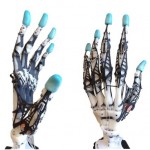 Hand Tendons Hand Tendons |
Growing Robot "Organs"
Bioprinting is an evolution of the 3D printing process using materials to which real cells can join to ("scaffolds"). Zhe Xu, a postdoctoral associate at Yale, co-led a team looking to grow tendons on robotic hands. This may mean that the future of prosthetics may become blurred with actual living tissue. They envision 3D printing bones. The scene from the movie The Fifth Element comes to mind where the character Leeloo is re-created using a type of biological 3D printing process.
Although not entirely robotic, the Mercedes "BIOME" concept car uses the idea of growing a frame rather than machining it. The concept is not as far-fetched as one might think; the company Ecovative Design grows mushrooms / fungus into specific shapes which are rigid enough to be used as support material and packaging.
Out of the Box
The Modular Body website tells the (fictional) story of "building" a living organism. This however is quickly becoming a reality, with more and more complex biological parts being created using various means. Once we have mastered re-creating existing biology, why not try to improve upon it? This might mean making systems more modular, powerful, long-lasting / robust or versatile. DNA currently provides a sort of "hard coded" framework and is the fundamental building block for life as we know it. Although recent advances in medicine and science have allowed us to map the human genome and even make small changes to DNA, it may be easier to create a basic "robot DNA" which gives the robot the chance to replicate and perhaps even evolve.
There is no reason why bioprinting or using biological matter with robots would be limited to scaffolding or inanimate structural elements; perhaps the biological matter used could indeed be alive, with cells which reproduce and heal, or even re-grow lost limbs. The prospect of creating a new biological / living design would be of interest to a wide variety of fields. Imagine designing a new vocal system able to emulate sounds from a wide variety of animals, or an artificial tongue for taste. |
Robot Intelligence
In the future, how will robots think? Will we continue the trend of reducing the size and increasing the complexity of
microchips and electronics, or rather look to nature and evolution as inspiration? Will a robot's actions be dictated by pre-programmed, inflexible code which helps it abide by the four laws of robotics, or rather guided based on thought processes and previous experiences?
Mobile robots are currently designed with specific goals and functionality in mind (ex
robot vacuum,
robot lawn mower or
robot arm), meaning their programming is purpose-driven and relatively fixed / inflexible. In terms of computing power, the tendency is to get "more for less", and cell phones and
single board computers like the
Raspberry Pi Zero are good examples of this trend.
Arduino has gained significant popularity as the programming (as well as the hardware) has allowed many people to share useful information regarding code, design approaches and more. Currently only universities and research institutions have the skills and resources to invest heavily in programming a robot to "learn" new tasks.
 Neuro Chip Neuro Chip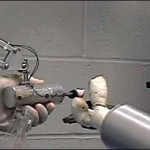 Brain Robot Interface Brain Robot Interface |
Artificial Neurons
The question eventually had to be asked - if living organisms are able to do significantly more than what modern computers are able to, why don't we try to emulate or learn from actual brains? Fields such as neurobiotics, computational neuroscience and others are looking, in their own ways, to model, map, use and emulate the ability of neurons to communicate and formulate decisions / thoughts. There are many different goals and approaches, and it's difficult to predict what the future will hold. A brain-computer interface is a electro-mechanical interface between a wired brain and an external device such as a computer. Currently the real-world application of the research is to create prosthetic devices which operate based on a patient's neuron output.
Out of the Box
A "neuro chip", either grown artificially or produced via more traditional means, has the potential to be at the forefront of artificial life. "Programming" would take on a while new meaning if a robot's brain is grown rather than manufactured. If research is ultimately able to grow an artificial brain cell with neurons, there is no reason why a "robot brain" could not become more biological in nature. This vision may be a bit far-fetched given the current state of the technology, but the prospect of creating an artificial life form capable of thinking (and perhaps even evolving) on its own would be revolutionary. The big question becomes the ethical issues involved. |
 Thinking Robot Thinking Robot Robot Partner Robot Partner |
Natural Development
What would happen if technology were created which allowed a robot to evolve and learn on its own? Unlike current living creatures (humans included) which can only take in so much information at a time from on our immediate surroundings, robots are not limited to the information in their physical space and can access the entirety of the Internet while at the same time doing a multitude of other tasks. The current approach is to develop code which can not only find information but make sense of it, and then use it to make decisions, with the goal to make a "higher intelligence".
The "technological singularity" is a hypothetical event where an artificially created "intelligence" becomes capable of improving itself (and its intelligence) automatically. Although we are only starting to entertain the possibility of robots which learn, Microsoft's recent AI chatbot showed that allowing a system free access to information on which to base its learning may not always lead to the desired outcome. There is a big difference between information, knowledge and wisdom, and to quote Miles Kington, "Knowledge is knowing that a tomato is a fruit, wisdom is not putting it in a fruit salad".
Out of the Box
Would a robot capable of teaching itself and making its own decisions be too dangerous to be left to its own devices? Isaac Asimov (and many others) foresaw this dilemma long ago, and that it will be a critical milestone in the evolution of robotics as well as presenting ethical issues. Without all of the normal senses, or even with added senses, would we want a robot react as a human would in a given situation, or would we be prepared to accept that "it" views the world differently and whose decisions and actions may be different than ours? A long list of issues such as robot rights, life and death, as well as ownership will arise and need to be addressed. |
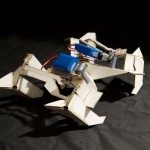 Origami Robot Origami Robot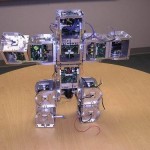 Self-assembling Robot Self-assembling Robot |
Self-Assembly
"Self-assembling" robots can come in many forms: imagine small nano robots which can join together to create larger objects, complete with environmental feedback, the ability to move and ways to interact. The "intelligence" of this larger creation may be somewhat identical for each nano-robot, or, when together, form a "collective". Although nanotechnology has advanced quite far, the fundamental building block needed for such a system, based on the number of different components needed (motors and motor controllers, for motion, a microcontroller, sensors, battery, wireless data transfer etc), these building blocks tend to be quite large and expensive, and the forms they create a somewhat rudimentary.
Another method of self-assembly was shown using an "origami robot" which is built using shape memory polymers which contract when heated, creating fold lines. Although the current approach uses single line folds, it is easy to imagine creating complex 3D shapes. Other examples include objects which can be "shaken" in order to self-assemble, and others which take shape based on inherent springiness built into their designs.
Out of the box
The thought of robots making robots is nothing new. Many science fiction movies have included advanced robots which "grow", evolve or are based upon fundamental building blocks. Even the Terminator T-1000 and its shape-shifting / liquid-like body would need to have been based on nanotechnology. |
Advanced power? Battery tech?
One of the biggest issues facing mobile robots is
power. Mobile robots use electrochemical batteries (
LiPo,
NiMh among others) to power their
actuators and
controllers, and their autonomy between charges is quite restricted. These batteries need to be charged externally, often from the power grid, during which time the robot cannot be operated (unless another battery is used). Although there is research being done into advancing Lithium-based batteries,
fuel cells and hydrogen, it's difficult to predict which technology will allow for the next giant leap in robot autonomy. Will robots always rely on electricity for power, especially given how fast technology is developing?
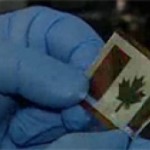 Spray Solar Panels Spray Solar Panels |
Spray-on, flexible solar panels
When you hear the term "solar panel", you might imagine a large blue, rigid rectangle which is used more and more to power homes or small toys. Now re-imagine instead being able to be apply a coating of "solar nanoparticles" to a thin & flexible surface. Although the efficiency of these solar cells is not great, there is tremendous potential.
Out of the Box
Imagine the possibility if almost any surface (rigid, flexible or even stretchable) could be covered in solar nanoparticles? Although it is difficult to envision the efficiency of energy conversion being incredibly high, this coating could be used to provide power to charge batteries, without adding any significant weight to the robot.
|
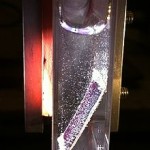 Photoelectric Cell Photoelectric Cell |
Artificial photosynthesis
What if robots could use the sun to create energy which can be stored? Unlike solar power, the products of the photosynthetic process are carbohydrates and oxygen. Photocatalytic water splitting converts water into hydrogen ions and oxygen. Just like planetary rovers on Mars, mobile robots on Earth should not have to rely on being re-charged from the grid. Although the current approach to stored energy seems to be with Lithium, Hydrogen has proven to be incredibly competitive in terms of a high capacity yet lightweight energy storage method.
Out of the Box
Imagine a drone (aircraft) which used a combination of photosynthesis (using moisture in the air) to replenish hydrogen reserves (significant advantage in weight over conventional Lithium batteries), as well as solar panels. The same could apply to water-based autonomous craft. This stored energy does not necessarily need to be converted to electricity either, and perhaps instead might be used to power (or even help re-build) artificial muscles. |
 Ultracapacitors Ultracapacitors |
Supercapacitors / ultracapacitors
Supercapacitors (or ultracapacitors) are electrical energy storage devices which can not only retain a high level of charge, but can be charged and discharged very quickly over many more cycles than conventional capacitors or rechargeable batteries. This makes them (currently) ideal for fast charging applications. Supercapacitors are currently considerably more expensive than Lithium in terms of cost per watt-hour and are considerably heavier for the same capacity.
Out of the Box
If the technology or a derivative thereof can be improved to the point where the cost is similar to Lithium, and the weight for the capacity is vastly improved, supercapacitors have tremendous potential for almost eliminating charging time, vastly improving discharge rates and prolonging the useful life of each cell. |
Disciplines like mechanical, electrical and computer engineering may only partly contribute to where robotics will be in the distant future. Companies and
educational institutions which are at the cutting edge of robotics may not even be aware of the application of their research towards robotics, only to have it revolutionize the field. In the future, what comes to mind now when we hear the term "robot" may be nowhere close to the reality in 100 years.
So where is all this heading? Although the objective for some may be to replicate humanoids, many people see beyond and envision creating artificial life which is far more advanced than humans, both in terms of physical capabilities and intelligence. What will mobile robots of the future look like? Do we really want to make them in our of likeness, or would they look more like a futuristic, advanced and adaptable alien species? We can certainly draw inspiration from nature, as well as advancing the current technologies used in robotics, but it is important to think outside the box when it comes to imagining the next major leap forward.
Read more:
New Technology: Biorobotic Stingray
What disruptive technology do you see in the future? What will its impact be on robotics? Leave your comments below.
Sources
Flexible, Non-Rigid Structure
fastcompany.com/3022517/fast-feed/soft-deformable-robots-are-a-new-frontier-in-robotics
theverge.com/2014/4/16/5617290/soft-robotics-is-booming
zdnet.com/article/soft-robot-uses-air-to-move/
spectrum.ieee.org/automaton/robotics/robotics-software/irobot-soft-morphing-blob-chembot
hizook.com/blog/2011/10/11/new-soft-robots-use-electropermanent-ep-magnet-valves-and-hydrogen-peroxide-pneumati
spectrum.ieee.org/tech-talk/robotics/robotics-hardware/a-superstretch-selfhealing-artificial-muscle
futurism.com/this-robotic-skin-can-glow-in-the-dark-change-colors-and-stretch-like-an-octopus/
Related topics: Elastic electronics; soft robots; artificial muscles;
Robot Skin & Senses
gizmodo.com/5995469/new-artificial-electric-skin-will-let-robots-feel-for-real
spectrum.ieee.org/biomedical/bionics/synthetic-skin-sensitive-to-the-lightest-touch
spectrum.ieee.org/tech-talk/semiconductors/materials/artificial-skin-can-feel-and-heal
popsci.com/researchers-make-artificial-cells-that-can-replicate-themselves
techinsider.io/researchers-to-grow-tendon-on-robot-hand-2016-2
en.wikipedia.org/wiki/Semi-biotic_systems
en.wikipedia.org/wiki/Synthetic_biology
en.wikipedia.org/wiki/Hybrot
Related topics: Robotic skin; artificial skin, self-healing artificial cells; semi-biotic systems; hybrot
Natural Development
en.wikipedia.org/wiki/Artificial_intelligence
birmingham.ac.uk/postgraduate/courses/taught/psych/computation-neuro-cognitive-robotics.aspx#CourseDetailsTab
en.wikipedia.org/wiki/Technological_singularity
en.wikipedia.org/wiki/Developmental_robotics
en.wikipedia.org/wiki/Cognitive_robotics
Related Topics: Artificial Intelligence, Developmental Robotics, Biomimetic development, Technological singularity; Cognitive Robotics, Self-evolving robots
Growing Robots
themodularbody.com/
en.wikipedia.org/wiki/3D_bioprinting
stratasys.com/materials/polyjet/digital-materials
techtimes.com/articles/5236/20140405/3-d-3d-printed-human-organs-not-just-science-fiction.htm
3dprintingindustry.com/2013/09/06/3d-printing-breakthrough-yields-organic-and-inorganic-multimaterial-vista-printhead/
themodularbody.com/
ecovativedesign.com/
gizmag.com/mercedes-benz-biome-concept/17096/
Related Topics: 3D Bioprinting, biorobotics, & 3D Printed digital materials
Robot Intelligence
en.wikipedia.org/wiki/Neurorobotics
en.wikipedia.org/wiki/Brain%E2%80%93computer_interface
en.wikipedia.org/wiki/Cultured_neuronal_network
Related Topics: Neurobotics, Computational Neuroscience, Cultured Neuronal Networks, Brain-computer interface & Neuroprosthetics
Self-assembly
theguardian.com/technology/2014/aug/07/self-assembling-origami-robot-transformer
spectrum.ieee.org/nanoclast/semiconductors/materials/tesla-coil-remotely-induces-nanotubes-to-self-assemble
Related Topics: metal-elastomer composite
Spray-on Solar Cells
cbc.ca/news/technology/cheap-spray-on-solar-cells-developed-by-canadian-researchers-1.1913086http://www.forbes.com/sites/jenniferhicks/2014/12/31/spray-on-solar-cells/#467ba6f675a2
Artifical Photosynthesis
https://en.wikipedia.org/wiki/Artificial_photosynthesis

 Neuro Chip
Neuro Chip Brain Robot Interface
Brain Robot Interface Thinking Robot
Thinking Robot Robot Partner
Robot Partner Origami Robot
Origami Robot Self-assembling Robot
Self-assembling Robot Spray Solar Panels
Spray Solar Panels Photoelectric Cell
Photoelectric Cell Ultracapacitors
Ultracapacitors







